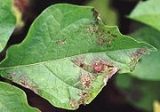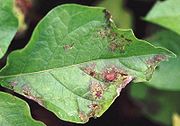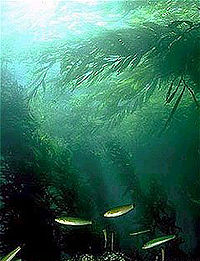
Chromalveolate
Encyclopedia
Chromalveolata is a eukaryote
supergroup first proposed by Thomas Cavalier-Smith
as a refinement of his kingdom
Chromista
, which was first put forward in 1981. Chromalveolata was proposed to represent the result of a single secondary endosymbiosis between a line descending from a bikont
and a red alga that became the progenitor of chlorophyll c
containing plastid
s. In a major classification produced in 2005, Chromalveolata was regarded as one of the six major groups within the eukaryotes. However this has been increasingly challenged. Thus two papers published in 2008 have phylogenetic trees in which the chromalveolates are split up.
s, because of their cell walls, photosynthetic ability, and in some cases their morphological resemblance to the land plants (Embryophyta). However, when the five-kingdom system took prevalence over the animal-plant dichotomy, most chromalveolates were put into the kingdom Protista, with the water molds and slime nets
put into the kingdom Fungi, and the brown algae
staying in the plant kingdom.
In 2005, in a classification reflecting the consensus at the time, the Chromalveolata were regarded as one of the six major clade
s of eukaryotes. Although not given a formal taxonomic status in this classification, elsewhere the group has been treated as a Kingdom. The Chromalveolata were divided into four major subgroups:
Other groups which may be included within, or related to, chromalveolates, are:
Though several groups, such as the ciliate
s and the water molds, have lost the ability to photosynthesize, most are autotroph
ic. All photosynthetic chromalveolates use chlorophyll
s a and c, and many use accessory pigments. Chromalveolates share similar glyceraldehyde 3-phosphate dehydrogenase
proteins.
However, as early as 2005, doubts were being expressed as to whether the Chromalveolata was monophyletic, and a review in 2006 noted the lack of evidence for several of the supposed six major eukaryote groups, including the Chromalveolata. there seems to be an emerging consensus that the group is not monophyletic. The four original subgroups fall into two categories, one comprising the Cryptophyta and the Haptophyta, the other the Stramenopiles and the Alveolata.
(plants in the very broad sense), being a sister group in one analysis, and actually nested inside this group in another. (Earlier, Cavalier-Smith had suggested a clade called Corticata
for the grouping of all the chromalveolates and the Archaeplastida.) Halvaria and Rhizaria
together form the SAR supergroup
. The SAR supergroup and the Archaeplastida/Hacrobia combination are grouped in the bikont
s, which all appear to descend from a heterotrophic eukaryote with two flagella.
The only common chromalveolate features are these:
Since this is such a diverse group, it is difficult to summarize shared chromalveolate characteristics.
 Many chromalveolates affect our ecosystem in enormous ways. Some of these organisms can be very harmful. Dinoflagellate
Many chromalveolates affect our ecosystem in enormous ways. Some of these organisms can be very harmful. Dinoflagellate
s produce red tide
s which can devastate fish populations and intoxicate oyster harvests. Apicomplexans are some of the most successful specific parasites to animals. Water molds cause several plant diseases. In fact, it was a water mold, Phytophthora infestans
, that caused the Irish potato famine.
 However, many chromalveolates are vital members of our ecosystem. Diatom
However, many chromalveolates are vital members of our ecosystem. Diatom
s are one of the major photosynthetic producers, and as such produce much of the oxygen
we breathe, and also take in much of the carbon dioxide
from the atmosphere. Brown algae
, most specifically kelp
s, create underwater "forest" habitats for many marine creatures, and provide a large portion of the diet of coastal communities.
Chromalveolates also provide many products that we use. The algin in brown algae is used as a food thickener, most famously in ice cream
. The siliceous shells of diatoms have many uses, such as in reflective paint, in toothpaste, or as a filter, in what is known as diatomaceous earth
.
Eukaryote
A eukaryote is an organism whose cells contain complex structures enclosed within membranes. Eukaryotes may more formally be referred to as the taxon Eukarya or Eukaryota. The defining membrane-bound structure that sets eukaryotic cells apart from prokaryotic cells is the nucleus, or nuclear...
supergroup first proposed by Thomas Cavalier-Smith
Thomas Cavalier-Smith
Professor Thomas Cavalier-Smith , FRS, FRSC, NERC Professorial Fellow, is a Professor of Evolutionary Biology in the Department of Zoology, at the University of Oxford...
as a refinement of his kingdom
Kingdom (biology)
In biology, kingdom is a taxonomic rank, which is either the highest rank or in the more recent three-domain system, the rank below domain. Kingdoms are divided into smaller groups called phyla or divisions in botany...
Chromista
Chromista
The Chromista are a eukaryotic supergroup, probably polyphyletic, which may be treated as a separate kingdom or included among the Protista. They include all algae whose chloroplasts contain chlorophylls a and c, as well as various colorless forms that are closely related to them...
, which was first put forward in 1981. Chromalveolata was proposed to represent the result of a single secondary endosymbiosis between a line descending from a bikont
Bikont
A Bikont is a eukaryotic cell with two flagella, as its name suggests. It is a division of eukaryotes.-Enzymes:Another shared trait of bikonts is the fusion of two genes into a single unit: the genes for thymidylate synthase and dihydrofolate reductase encode a singleprotein with two...
and a red alga that became the progenitor of chlorophyll c
Chlorophyll c
Chlorophyll c can refer to:* Chlorophyll c1* Chlorophyll c2* Chlorophyll c3...
containing plastid
Plastid
Plastids are major organelles found in the cells of plants and algae. Plastids are the site of manufacture and storage of important chemical compounds used by the cell...
s. In a major classification produced in 2005, Chromalveolata was regarded as one of the six major groups within the eukaryotes. However this has been increasingly challenged. Thus two papers published in 2008 have phylogenetic trees in which the chromalveolates are split up.
Groups and classification
Historically, many chromalveolates were considered plantPlant
Plants are living organisms belonging to the kingdom Plantae. Precise definitions of the kingdom vary, but as the term is used here, plants include familiar organisms such as trees, flowers, herbs, bushes, grasses, vines, ferns, mosses, and green algae. The group is also called green plants or...
s, because of their cell walls, photosynthetic ability, and in some cases their morphological resemblance to the land plants (Embryophyta). However, when the five-kingdom system took prevalence over the animal-plant dichotomy, most chromalveolates were put into the kingdom Protista, with the water molds and slime nets
Labyrinthulomycetes
The Labyrinthulomycetes also known as Labyrinthulomycota or Slime nets are a group of protists that produce a network of filaments or tubes, which serve as tracks for the cells to glide along and absorb nutrients for them. There are two main groups, the labyrinthulids and thraustochytrids...
put into the kingdom Fungi, and the brown algae
Brown algae
The Phaeophyceae or brown algae , is a large group of mostly marine multicellular algae, including many seaweeds of colder Northern Hemisphere waters. They play an important role in marine environments, both as food and for the habitats they form...
staying in the plant kingdom.
In 2005, in a classification reflecting the consensus at the time, the Chromalveolata were regarded as one of the six major clade
Clade
A clade is a group consisting of a species and all its descendants. In the terms of biological systematics, a clade is a single "branch" on the "tree of life". The idea that such a "natural group" of organisms should be grouped together and given a taxonomic name is central to biological...
s of eukaryotes. Although not given a formal taxonomic status in this classification, elsewhere the group has been treated as a Kingdom. The Chromalveolata were divided into four major subgroups:
- Cryptophyta
- Haptophyta
- Stramenopiles (or Heterokontophyta)
- Alveolata
Other groups which may be included within, or related to, chromalveolates, are:
- TelonemiaTelonemiaTelonemia is a phylum of microscopic eukaryote, single-celled organisms. They are protists and are suggested to have evolutionary significance in being a possible transitional form between ecologically important heterotrophic and photosynthetic species among chromalveolates.One paper places them in...
Though several groups, such as the ciliate
Ciliate
The ciliates are a group of protozoans characterized by the presence of hair-like organelles called cilia, which are identical in structure to flagella but typically shorter and present in much larger numbers with a different undulating pattern than flagella...
s and the water molds, have lost the ability to photosynthesize, most are autotroph
Autotroph
An autotroph, or producer, is an organism that produces complex organic compounds from simple inorganic molecules using energy from light or inorganic chemical reactions . They are the producers in a food chain, such as plants on land or algae in water...
ic. All photosynthetic chromalveolates use chlorophyll
Chlorophyll
Chlorophyll is a green pigment found in almost all plants, algae, and cyanobacteria. Its name is derived from the Greek words χλωρος, chloros and φύλλον, phyllon . Chlorophyll is an extremely important biomolecule, critical in photosynthesis, which allows plants to obtain energy from light...
s a and c, and many use accessory pigments. Chromalveolates share similar glyceraldehyde 3-phosphate dehydrogenase
Glyceraldehyde 3-phosphate dehydrogenase
Glyceraldehyde 3-phosphate dehydrogenase is an enzyme of ~37kDa that catalyzes the sixth step of glycolysis and thus serves to break down glucose for energy and carbon molecules...
proteins.
However, as early as 2005, doubts were being expressed as to whether the Chromalveolata was monophyletic, and a review in 2006 noted the lack of evidence for several of the supposed six major eukaryote groups, including the Chromalveolata. there seems to be an emerging consensus that the group is not monophyletic. The four original subgroups fall into two categories, one comprising the Cryptophyta and the Haptophyta, the other the Stramenopiles and the Alveolata.
Halvaria
Analyses in 2007 and 2008 agree that the Stramenopiles and the Alveolata are related, forming a reduced chromalveolate clade.Hacrobia
The Haptophyta and Cryptophyta are related in these analyses, forming a clade which has been called 'Hacrobia'.Position of SAR and Hacrobia
The Hacrobia appear to be more closely related to the ArchaeplastidaArchaeplastida
The Archaeplastida are a major group of eukaryotes, comprising the red and green algae and the land plants, together with a small group called the glaucophytes. The plastids of all of these organisms are surrounded by two membranes, suggesting they developed directly from endosymbiotic...
(plants in the very broad sense), being a sister group in one analysis, and actually nested inside this group in another. (Earlier, Cavalier-Smith had suggested a clade called Corticata
Corticata
Corticata , in the classification of eukaryotes , is a clade suggested by Cavalier-Smith to encompass the eukaryote supergroups of the following two groups:...
for the grouping of all the chromalveolates and the Archaeplastida.) Halvaria and Rhizaria
Rhizaria
The Rhizaria are a species-rich supergroup of unicellular eukaryotes. This supergroup was proposed by Cavalier-Smith in 2002. They vary considerably in form, but for the most part they are amoeboids with filose, reticulose, or microtubule-supported pseudopods...
together form the SAR supergroup
SAR supergroup
The SAR supergroup is a clade that includes Stramenopiles , Alveolates, and Rhizaria.The first letter of each group provides the "SAR" in the name.It includes most of the organisms in the Chromalveolata grouping, but not Hacrobia....
. The SAR supergroup and the Archaeplastida/Hacrobia combination are grouped in the bikont
Bikont
A Bikont is a eukaryotic cell with two flagella, as its name suggests. It is a division of eukaryotes.-Enzymes:Another shared trait of bikonts is the fusion of two genes into a single unit: the genes for thymidylate synthase and dihydrofolate reductase encode a singleprotein with two...
s, which all appear to descend from a heterotrophic eukaryote with two flagella.
Morphology
Chromalveolates, unlike other groups with multicellular representatives, do not have very many common morphological characteristics. Each major subgroup has certain unique features, including the alveoli of the Alveolata, the haptonema of the Haptophyta, the ejectisome of the Crytophyta, and the two different flagella of the Heterokontophyta. However, none of these features are present in all of the groups.The only common chromalveolate features are these:
- The shared origin of chloroplasts, as mentioned above
- Presence of celluloseCelluloseCellulose is an organic compound with the formula , a polysaccharide consisting of a linear chain of several hundred to over ten thousand β linked D-glucose units....
in most cell walls
Since this is such a diverse group, it is difficult to summarize shared chromalveolate characteristics.
Ecological role

Dinoflagellate
The dinoflagellates are a large group of flagellate protists. Most are marine plankton, but they are common in fresh water habitats as well. Their populations are distributed depending on temperature, salinity, or depth...
s produce red tide
Red tide
Red tide is a common name for a phenomenon also known as an algal bloom , an event in which estuarine, marine, or fresh water algae accumulate rapidly in the water column and results in discoloration of the surface water. It is usually found in coastal areas...
s which can devastate fish populations and intoxicate oyster harvests. Apicomplexans are some of the most successful specific parasites to animals. Water molds cause several plant diseases. In fact, it was a water mold, Phytophthora infestans
Phytophthora infestans
Phytophthora infestans is an oomycete that causes the serious potato disease known as late blight or potato blight. . Late blight was a major culprit in the 1840s European, the 1845 Irish and 1846 Highland potato famines...
, that caused the Irish potato famine.

Diatom
Diatoms are a major group of algae, and are one of the most common types of phytoplankton. Most diatoms are unicellular, although they can exist as colonies in the shape of filaments or ribbons , fans , zigzags , or stellate colonies . Diatoms are producers within the food chain...
s are one of the major photosynthetic producers, and as such produce much of the oxygen
Oxygen
Oxygen is the element with atomic number 8 and represented by the symbol O. Its name derives from the Greek roots ὀξύς and -γενής , because at the time of naming, it was mistakenly thought that all acids required oxygen in their composition...
we breathe, and also take in much of the carbon dioxide
Carbon dioxide
Carbon dioxide is a naturally occurring chemical compound composed of two oxygen atoms covalently bonded to a single carbon atom...
from the atmosphere. Brown algae
Brown algae
The Phaeophyceae or brown algae , is a large group of mostly marine multicellular algae, including many seaweeds of colder Northern Hemisphere waters. They play an important role in marine environments, both as food and for the habitats they form...
, most specifically kelp
Kelp
Kelps are large seaweeds belonging to the brown algae in the order Laminariales. There are about 30 different genera....
s, create underwater "forest" habitats for many marine creatures, and provide a large portion of the diet of coastal communities.
Chromalveolates also provide many products that we use. The algin in brown algae is used as a food thickener, most famously in ice cream
Ice cream
Ice cream is a frozen dessert usually made from dairy products, such as milk and cream, and often combined with fruits or other ingredients and flavours. Most varieties contain sugar, although some are made with other sweeteners...
. The siliceous shells of diatoms have many uses, such as in reflective paint, in toothpaste, or as a filter, in what is known as diatomaceous earth
Diatomaceous earth
Diatomaceous earth also known as diatomite or kieselgur/kieselguhr, is a naturally occurring, soft, siliceous sedimentary rock that is easily crumbled into a fine white to off-white powder. It has a particle size ranging from less than 1 micrometre to more than 1 millimetre, but typically 10 to...
.

